What is enrichment? The Association of Zoos and Aquariums (AZA) Behavior Scientific Advisory Group (BAG) defines enrichment as “a dynamic process for enhancing animal environments within the context of the animals’ behavioral biology and natural history.” But what the heck does that actually mean, right? Most zoos and wildlife sanctuaries, especially those that are AZA accredited here in the United States, are focusing more and more on enrichment. Basically they want to be able to stimulate captive animals to exhibit the same behaviors as they would out in the wild. Stimuli can be anything from types of foods offered, to various scents in the habitats, to noises, to exposure to other species, to puzzles and toys, and so on.
There are an infinite number of ways to provide enrichment for animals. Those of you who have cats and dogs probably provide enrichment all the time without even realizing it. Do you ever give your cat a toy mouse to play with? How about giving your dog a treat or a rope toy? Toys can hone your pet’s hunting or foraging skills. The various smells and taste of treats or catnip stimulate your pet’s senses too.
 Exotic animals in captivity require these types of stimuli as well, regardless of whether they reside in a zoo or in your home. Even if you bought your tortoise or other reptile in a pet store, it is not domesticated and still has wild instincts. Your exotic pet can develop behavioral problems and possibly even have a shorter life span if not provided with enrichment.
Exotic animals in captivity require these types of stimuli as well, regardless of whether they reside in a zoo or in your home. Even if you bought your tortoise or other reptile in a pet store, it is not domesticated and still has wild instincts. Your exotic pet can develop behavioral problems and possibly even have a shorter life span if not provided with enrichment.
So the really big question here is what kind of enrichment can you provide for a tortoise? If you walk into a pet store it’s easy to find toys for cats, dogs, birds, and even small animals like hamsters and guinea pigs. But what about reptiles? They don’t exactly chase catnip filled toy mice or play fetch.
But there are plenty of ways to enrich reptiles and stimulate natural behaviors. Whether you have a baby tortoise in a glass aquarium or table top enclosure or you have a larger tortoise in an outdoor enclosure, one of the easiest ways to provide enrichment is to change the habitat intermittently. If the enclosure has plants or a hide box, occasionally move them to different areas of the enclosure. It gives the animal an opportunity to explore a changed environment. I also like to make the substrate different depths or form slight mounds of substrate for them to climb over. You don’t want to make the mounds too steep or high though. We don’t want to cause the tortoise to accidentally flip over. Providing various types of substrates in the enclosure is also great enrichment. However, do use caution with the types of substrates you provide. Some substrates can cause impaction or choking hazards.
You can also stimulate your tortoise’s senses by providing a variety of greens, grasses, weeds, and herbs in his or her diet. I like to add fragrant herbs like cilantro, parsley or dill to the regular diet. Cilantro is particularly popular in my house, not just with the tortoises, but also with the bearded dragons and birds. Edible flowers are also a great form of enrichment.
They stimulate senses of taste and smell like the herbs, and are also bright and colorful which are very attractive to tortoises. I frequently feed hibiscus and marigold. I also have some nasturtium growing in the raised garden bed that will be ready to feed out in a few weeks. If you have your tortoise in an outdoor habitat, try planting some greens, grasses, or edible flowers right in the enclosure for your tortoise to graze on leisurely. Food enrichment can also be provided by changing the size or shape of the pieces of food given to the tortoise. You can change things up by sometimes breaking or cutting food into smaller pieces and then other times leaving the food in larger pieces or chunks.
While most people wouldn’t blink at the idea of giving a cat or dog a toy to play with, I often get side-ways glances and raised eyebrows when I tell people I buy toys for my tortoises.I make sure to buy sturdy dog and cat toys so that they can’t eat or break them. KONG dog and cat toys seem to work well for them. I like to put some small treats like corn kernels in the KONG and let them figure out how to get the treats out. One of the cat toys has a rattle inside of it that they like to push around and play with too. I even put the toys in the bath tub with them sometimes so they have something to keep them occupied while soaking (my little ones seem to get bored after about 7-8 minutes of being in the bath).
You should always supervise your pet’s time with toys just in case the toy breaks or your pet is actually able to bite or chew the toy apart. If you have a larger tortoise like a sulcata or aldabra, you can also try giving them a Boomer Ball. They are a little pricey, but very sturdy for larger, stronger animals.
Behavioral conditioning helps stimulate cognitive brain function or basically keeps the animal’s brain active. I have begun target training with my tortoises. I did this for a couple reasons. The first is that I know it’s a great form of enrichment for my tortoises. The second is that, let’s face it, when my tortoises are full grown, I won’t be able to just pick them up and move them if I need to. I have to have a way to get them from point A to point B that won’t break my back. Because they’re small right now, I simply use a solid black pen with different colored pencil erasers as my target stick. I use a pink eraser for Tambara and a yellow eraser for Kada. I hold the target stick in place and say “(the tortoise’s name), target”. When the tortoise goes to the target stick and touches her beak to the tip of the target stick she gets a kernel of corn as a reward. I only use positive reinforcement training with all of my animals. If she does the wanted behavior, she gets rewarded. If she doesn’t do the behavior, she doesn’t get a reward, period. I never shout, make scary noises, or hit my animals. Negative reactions only cause your animals to be fearful of you and can damage or destroy any type of bond you have or may have in the future. I will provide more detailed training information in a future post, but know that if you do want to train your tortoise or other reptile, it takes PATIENCE. Reptile brains don’t work like mammal and bird brains. They don’t react as quickly and you need to understand that to be successful.
And lastly, if you can socialize your tortoise, that is also a wonderful way to enrich him or her. Though they are safely separated by a mesh enclosure, my tortoises spend almost all of their outside time with my bearded dragon, Matilda. It’s great for all three of them to experience being around another species.
They also get to encounter a variety of wildlife when they hang out on the patio. I have a squirrel, three cardinals, two doves, and what seems like hundreds of anoles that come to visit daily. I also get the occasional snake or frog that stops by to get a drink after I water the garden. The sights, sounds, and smells of other animals stimulates their senses and their minds in ways that no toy or food ever could.
Most zoos construct enrichment plans that detail what the goal of providing the enrichment is. It’s not necessary to be that detail-oriented with your tortoise at home, but it’s still a good idea to make sure you provide a variety of stimuli. It’s very easy to get into a habit of just giving different types of food and thinking that’s enough enrichment, but it’s not. You want to stimulate the whole mind and body so that your tortoise stays happy and healthy. If you have other enrichment ideas, please share with us. I always like to hear about tortoises having fun.
For more information on enrichment and enrichment items please visit:
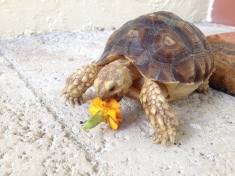
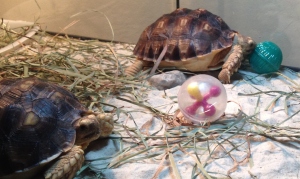
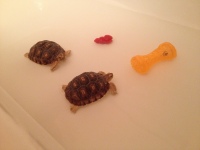
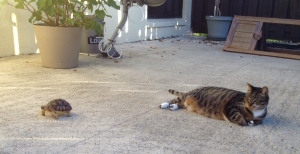
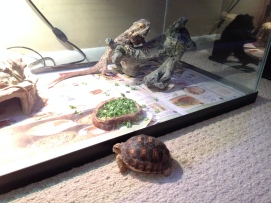
Pingback: 21 Pet Tortoise Enrichment Ideas [Budget Friendly] – 903Pets
Pingback: Week 10; March 24th – Work Skills
I love to hear this!!! Foraging is one of the most natural behaviors we can encourage. And exercise in the natural sunlight is always a bonus. Keep up the great tortoise parenting! Sounds like you’re doing an awesome job!
LikeLike
Hi there, I have a Hermanns (female, I think) who is only 1 so is very small. I let her out her pen as much as possible, but she can only come out under my supervision since the house isnt suitable to leave her roaming at the moment (due to her size and one of my dogs who loves to torment her). What kind of things could I put in her house to make it more exciting whilst I’m at work. Although she comes down to play in the evenings I often come home to find her desperate to get out which makes me think her house is too boring.
(also any advice on bathing her?)
Thanks 🙂 🙂
LikeLike
Hello Tatjana! Well let me start with an answer to the easy question. As far as bathing her, you can try using a small container and filling it with maybe an inch or two of luke warm water 1-2 times/week. I bought one of those plastic totes and used it as a bathtub when my guys were smaller. The tote was roughly the size of a shoebox and it was only about $2.00 so it didn’t break the bank. Just make sure you don’t fill the water too high. They aren’t made for swimming 🙂
As far as things to put in her enclosure, there are very small dog and cat toys that you can try. But if you do place anything like that to leave unattended, just make sure she can’t bite pieces of it off to accidentally swallow. You can also try placing her food in 2-3 areas of the enclosure. This will give her something to look for and keep her busy while your away. However, another thought that occurred to me is that if she’s seems like she’s trying to get out, make sure that you have a cool spot for her and that she’s not trying to get away from a heating lamp or pad because she’s too warm. Without knowing exactly what your set up looks like, it’s hard for me to say that this is the case, but just a possibility from some enclosures I’ve seen in the past.
It sounds like you give your little tortoise lots of love and attention!! That’s great and I’m always happy to hear that torts are being cared for so wonderfully! I hope the info helps keep your girl busy!
LikeLike
I read that it is extremely stressful to change the habitat of a tortoise, as they become accustomed to their environment. So I wouldn’t recommend your suggestion of changing the enclosure setup.
LikeLike
Hi Jim. I apologize for my delayed response. I wanted to research your concerns before I responded. If I may ask, from what source did you read this advice from? In my research and years of experience, I have not come across any credible sources that say simply changing the environment causes detrimental stress. There are environmental factors that can cause a large amount of stress. For example, changing a food dish that makes it more difficult for the animal to access food or moving the enclosure closer to or away from a window or air vent can be causes of environmental stress. These are types of changes that we may not see as being stressful, but can cause a great deal of unhealthy stress to an animal. This is not to say that you can’t do these types of things, but you also have to watch for indications of both short-term and long-term stress and immediately make changes if any symptoms begin to appear.
However, my suggestions are of a different nature. If you have a food dish that the animal is comfortable using, my suggestion is to move that same dish to various locations around the enclosure once in a while. This encourages natural foraging behaviors. The purpose of enrichment is to encourage natural behaviors and stimuli that the animal would experience out in the wild. And in the wild, tortoises are exposed to habitat change and interaction with other animals constantly. Burrowing species, such as local (for me) Gopher tortoises can share their burrows with dozens of other species, which is why they are considered a keystone species and play an incredibly important role in the survival of those other species. Their burrows are beneficial to the environment. And because other species move in and out of the burrow throughout the year, their homes are constantly changing.
Please let me be clear, you need to know your pet, whether it is a tortoise, a bird, a dog, or any other animal. You need to be able to know your pet well enough to recognize if a situation is too stressful. What works for one animal may not for another. When I was a vet tech, I had a client bring her cockatoo in because it suddenly stopped eating. The only change that had been made in that bird’s world was that the woman had painted the room that the bird’s cage was in. Cage, toys, food, location, temperature and all other variables were the same, but the color of the walls caused a great deal of harmful stress for that individual animal. Once the room was painted back to a more similar color, the bird was fine. Many years ago I had a conure in my own home in the same situation. After painting the room and moving the bird back into the familiar environment, with the exception of the new wall color, she was fine and showed no signs of stress. You must get to know your pet’s normal behaviors. This is simply part of being a responsible pet owner.
There will be times that you introduce or change something that the animal may not like and that’s ok. Because believe it or not, a little stress is actually a good thing as long as it’s not long term or causing the animal physical harm. Animals get stressed for many reasons in the wild, but that stress is part of what keeps their survival instincts sharp and keeps their minds active. Sitting in the same environment day after day, year after year, is far more detrimental to their mental, and even physical, well-being than changing things up every once in a while.
LikeLike
This was lovely to read, it’s great that you do so much for your tortoises. I’ve been trying to make things interesting for my Horesfueld tortoise and have been doing a lot of reading on the internet. It’s sad that a lot of owners think they do not need it and just leave them in a table top. My tortoise was rescued and does not seem interested in most things. Hopefully by following some of your suggestions this may change. Thank you.
LikeLike
Thank you Rachel! Just keep trying new things for your little one. My bird was a rescue too and I often have the same trouble with her. She doesn’t have an interest in playing with toys the way most birds do. I just keep trying new things. Some are successes and some aren’t, but even if she decides she doesn’t like what I give her, it’s still giving her something to think about and to make a decision about. Good luck! And if you find something that your tortoise really enjoys, please share with us!
LikeLike
I love this aeticle, it has given me alot of ideas for my little tortoise baby.
LikeLike
Thank you!! If you find any new ideas that your little one really enjoys, please feel free to share too!
LikeLike
I have tried giving her a golf ball so far (she is tiny and it is hard enough she can’t bite chunks off it)- she does not push it around but she did come closer to have a look at it. Hopefully one day she will actually play with something. She is very interested in climbing onto her log house and then faceplanting down into substrate 😀
LikeLiked by 1 person